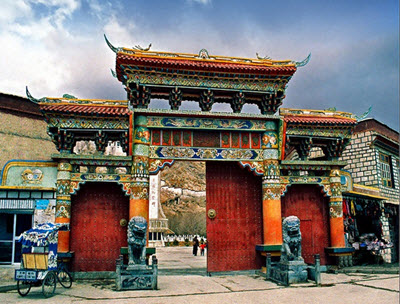In the People’s Republic of China, in the Tibet Autonomous Region, the Yarlung Valley sits with the beautiful Yarlung Tsangpo River running through it. To the south is India and Bhutan and north of the valley is Lhasa. The city’s of Shigatse and Nyingchi are to the west and east, respectively.
Shannon, a prefecture level city in the PRC, sits in the Yarlung Valley. It is also called Lhoka, or ‘south of the mountains”.
It takes up about 30,800 square miles of land at an average altitude of just over 12,000 feet. The population of Shannan is 98% Tibetan. The remaining population are a mixture of ethnic groups, including Han and Hui.
The region of Shannan is believed to be where Tibet has its origins. The Tubo Regime (The Tibetan Empire) was unified by Songtsen Gampo. He was the 33rd Tibetan king and the first to transform Tibet from a vast group of tribes, into a kingdom.
Songtsen Gampo is also traditionally credited for introducing Buddhism to the area, as a result of his marriages to his wives from Nepal and China. This gave Tibet its first and oldest palace, Yungbulakang Palace, and its first Buddhist Monastery. Shannan is also where the first Lhamo was performed, which is the Tibetan equivalent to classical opera.
A vastly rich and fertile area, Shannan has over 40 rivers. The mother of them all is the Yarlung Tsangpo, making this area strong in agriculture and animal husbandry. It is believed that this area was where the very first farming in Tibet took place.
During the reign of Songtsen Gampo, there were advancements in agriculture and irrigation and a great deal of progress. In the ensuing centuries, control of Shannan waffled back and forth between the Mongolian and Chinese dynasties and the Tibetans.
 At the end of the Yuan Dynasty (1368), the Phagmo Drupa Dynasty arose to establish a feudal serfdom and the governmental Zong system, much of which survived until the mid 1950s when Communist China took control.
At the end of the Yuan Dynasty (1368), the Phagmo Drupa Dynasty arose to establish a feudal serfdom and the governmental Zong system, much of which survived until the mid 1950s when Communist China took control.
The “peaceful liberation of Tibet” was a document drafted by China and signed by the Tibetan Delegation, under the 14th Dalai Lama, handing over control of Tibet to China in 1951.
Although Chinese sources regard the document as a legal contract, the Tibetans regard it as a contract signed under duress. Eight years later, in 1959, China annexed Shannon by force, destroying many monasteries and leaving the area replete with damage.
Shannan is a culturally and historically rich area of the Tibet Autonomous Region. Some of the most notable monuments are the Tombs of the Tibetan Kings. Songtsen Gampo, along with all of his successive royal family, ministerial leaders and concubines are buried there.
It is the only one of its kind in Tibet and boasts of a great quantity of funeral objects held in the burial chambers, like gold, silver and precious gemstones. Zamasang Palace, Namseling Manor, Samye Monastery, Gyigag Monastery, Dratang Monastery, Sekhar Gutok Monastery, and Sange Choeling Monastery are also important historical and national monuments found in Shannan.
There are three Buddhist meditation caves, rich with history and legend from the Buddhist monks and lamas. They are Nyimalung Holy cave, Qingpo Meditation caves, and Zayangzong Lava Cave.
Finally, Shannon has two of the Tibetan holy lakes of Yamdrok Yumtso Lake and Lhamo Latso Lake. They are believed to have been indwelt with sacred deities that protect the area and people.
Lhamo Latso, for instance, is named after the goddess that is supposed to protect the sacred lineage of the Dalai Lamas. This is just one example of how, through much of history, the Tibetan people have looked to the land and the waters surrounding Shannan for prosperity and protection.
